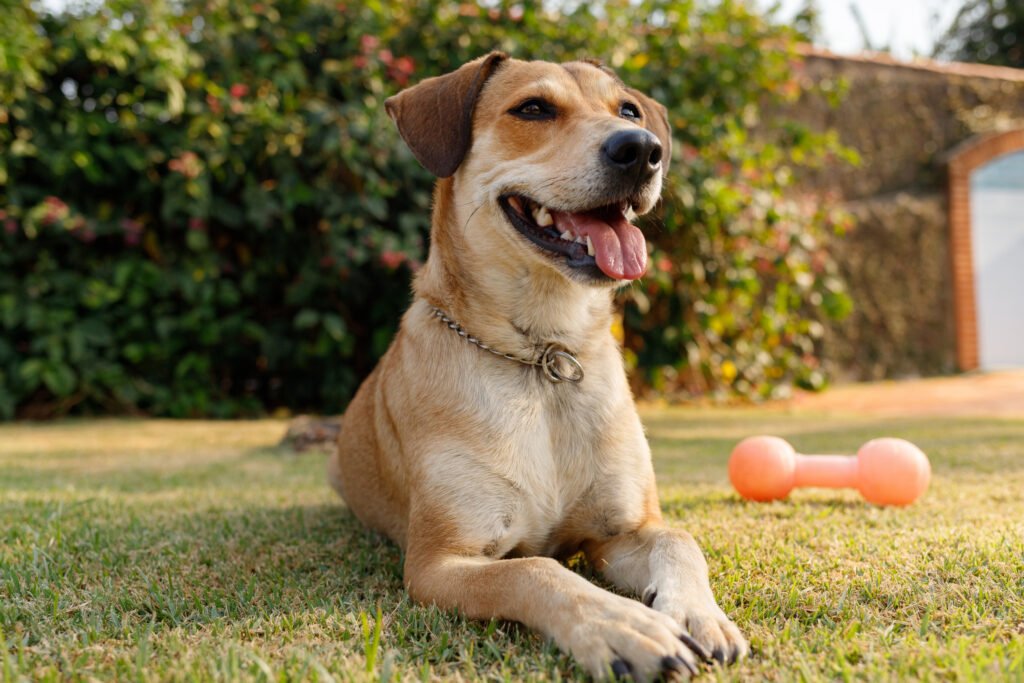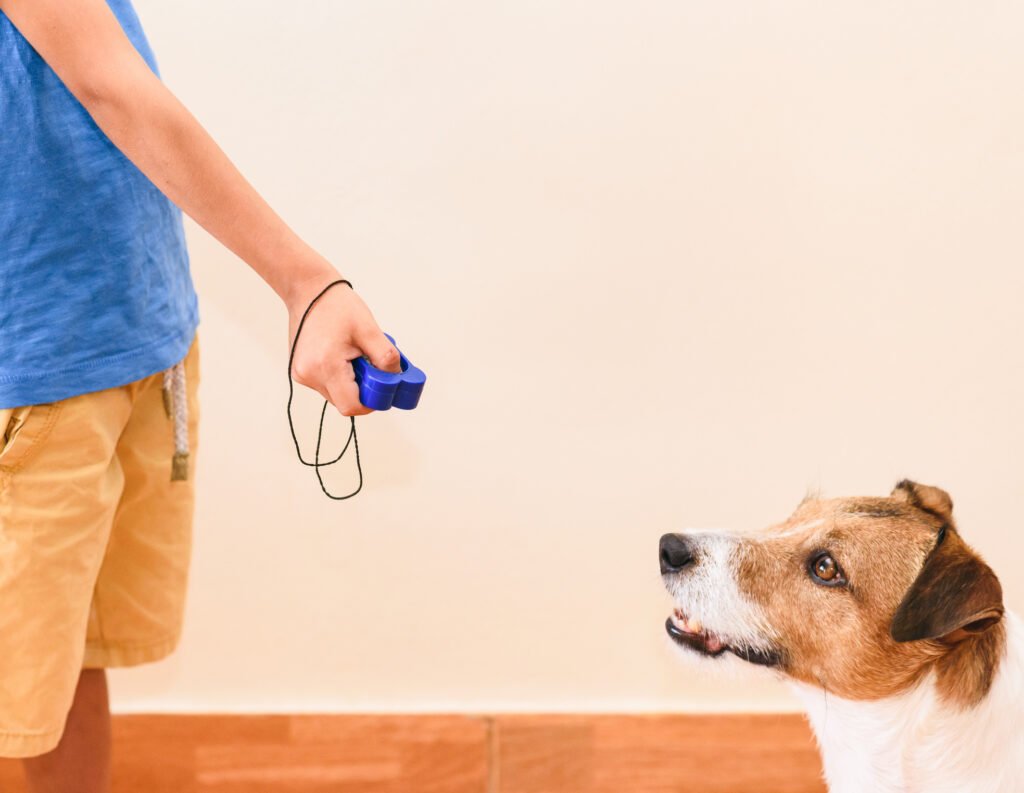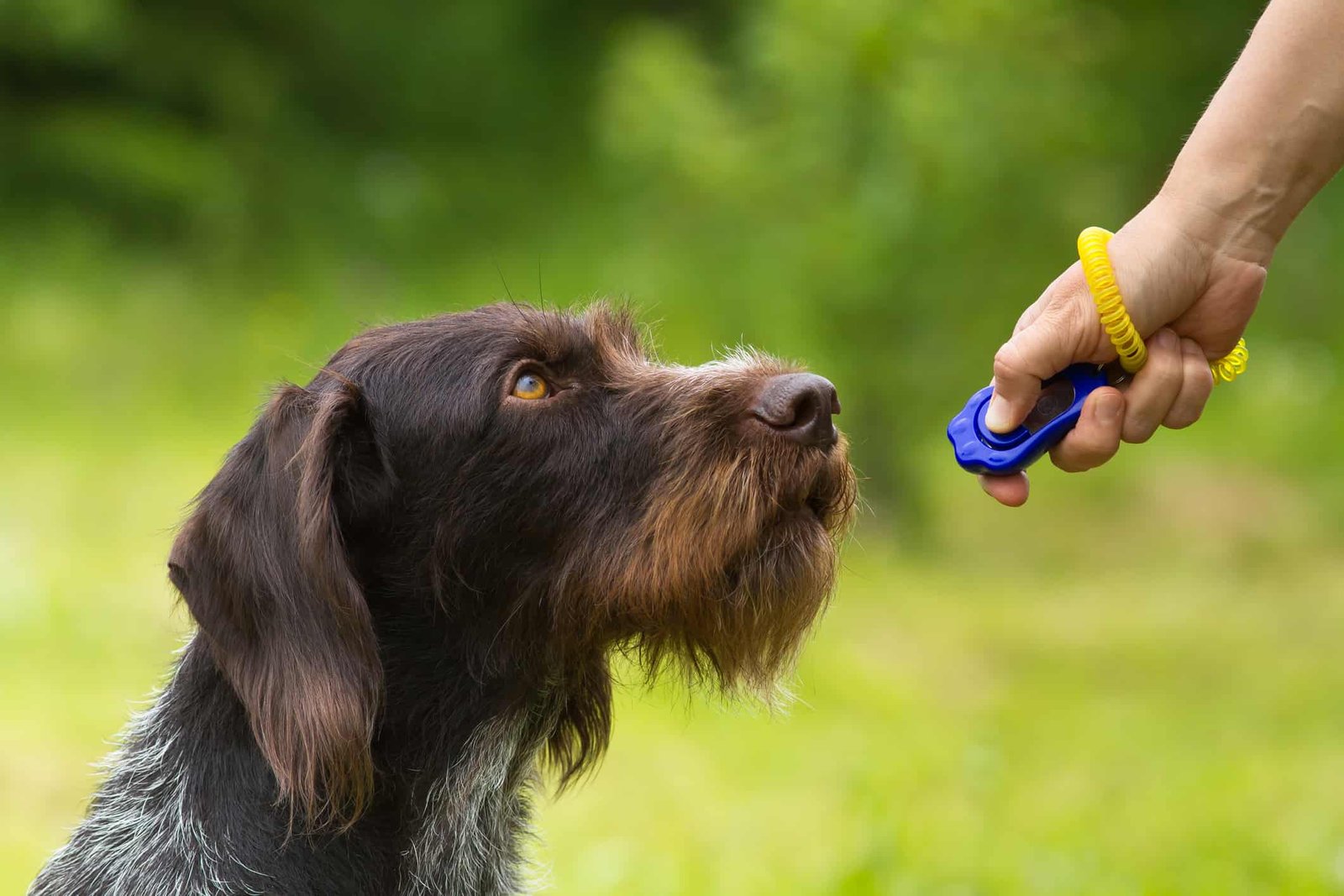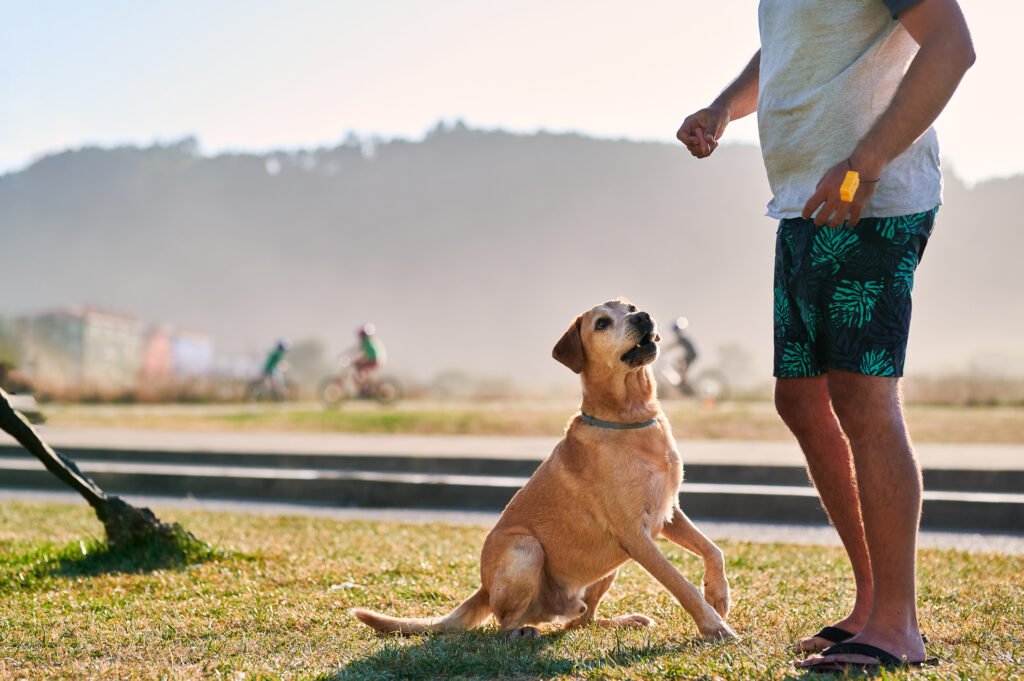Table of Contents
Are you interested in teaching your dog new commands and tricks? Look no further than clicker training! This method is not only fast and efficient, but it also provides consistent feedback to your furry friend. With clicker training, a clicker is used as a marker to indicate correct behavior, ensuring that your dog knows a reward is on its way. Say goodbye to confusion caused by tone or word variations – clicker training eliminates all of that. Not only can clicker training reinforce specific behaviors, but it can also give feedback from a distance. Whether you’re looking to teach basic obedience, advanced commands, or even agility work, clicker training can be applied in various types of dog training. Just remember, the key to success lies in timing, practice, and consistency. So, grab a clicker, get ready to have some fun, and let’s begin the training journey together!

Benefits of Clicker Training
Efficient way to teach commands or tricks
Clicker training is a highly efficient method to teach dogs various commands and tricks. The clicker serves as a marker to indicate correct behavior and that a reward is forthcoming. By using a clicker, you can communicate with your dog in a clear and consistent manner, making it easier for them to understand the desired behavior. This method allows for quick and effective learning, making it an ideal choice for training sessions.
Provides consistent feedback
One of the key benefits of clicker training is the consistent feedback it provides to dogs. Unlike verbal commands, which may vary in tone or word choice depending on the trainer’s mood or situation, the clicker always produces the same sound. This consistency allows dogs to understand immediately when they have performed the right behavior and facilitates faster learning. With clicker training, you can provide clear and reliable feedback to your dog, enhancing their understanding and progress in training.
Eliminates confusion
In traditional training methods, dogs may sometimes get confused due to inconsistent commands or mixed signals. However, clicker training eliminates this confusion by providing a clear marker for desired behavior. The distinct sound of the clicker signals to the dog that they are on the right track, helping them understand and replicate the correct behavior. By removing confusion, clicker training makes the learning process smoother and more effective.
Can start at a young age
Clicker training can be initiated at a young age, even as early as four to six weeks old. This early introduction to training not only helps puppies learn basic commands but also lays the foundation for their lifelong training and behavior. Starting clicker training early allows puppies to develop good habits and behaviors from the beginning, making it easier to prevent and correct undesirable behaviors as they grow older.
Can stop undesirable puppy behaviors
In addition to teaching new commands and tricks, clicker training can also effectively stop undesirable behaviors in puppies. By using the clicker to mark and reward desirable behaviors while redirecting and ignoring unwanted behaviors, you can effectively communicate to your puppy what is expected of them. This approach helps puppies understand which behaviors are rewarded and which should be avoided, which is crucial for their development and overall obedience.
Reinforces specific behaviors
Clicker training is not limited to just teaching basic commands or tricks. It can also be used to reinforce specific behaviors in dogs. Whether it’s reinforcing a calm and relaxed state or encouraging polite greetings, the clicker can be used as a tool to reward and reinforce desired behaviors. This reinforcement helps dogs understand which behaviors are valued and encourages them to repeat those behaviors in the future.
Gives feedback from a distance
One of the advantages of clicker training is that it allows for giving feedback from a distance. Unlike verbal commands that require the trainer to be in close proximity to the dog, the clicker can be heard from a distance. This makes it particularly useful for training behaviors that require distance, such as recall or agility training. With the clicker, you can provide immediate feedback to your dog, even when you are not physically close to them, strengthening their understanding and compliance with commands.
Types of Dog Training that Clicker Training is Suitable for
Basic obedience
Clicker training is highly suitable for teaching basic obedience commands to dogs. Whether it’s sit, stay, or come, the clicker can be used to mark and reinforce these fundamental behaviors effectively. The clear and consistent feedback provided by the clicker helps dogs understand the desired actions and facilitates faster learning and mastery of basic obedience commands.
Advanced obedience
Clicker training is not limited to basic obedience but can also be used for advanced obedience training. This includes teaching more complex commands, such as heel, shake, or roll over. By breaking down these advanced behaviors into smaller steps and using the clicker to mark and reinforce each correct action, dogs can quickly grasp and perform these more advanced commands with precision.
Service dog training
Clicker training is especially well-suited for service dog training. Service dogs need to learn a wide range of complex tasks and behaviors to assist individuals with disabilities or specific needs. Clicker training provides the clarity and consistency necessary to teach these tasks effectively. Whether it’s guiding the visually impaired or alerting to medical conditions, clicker training plays a vital role in shaping service dogs’ behaviors and enabling them to perform their duties reliably.
Scent work training
Scent work training involves teaching dogs to detect and identify specific odors. Clicker training can be used successfully in scent work training by associating the clicker with the odor the dog is trained to find. The clicker serves as a marker to indicate when the dog has located the target odor, allowing for precise and accurate reinforcement. This technique helps dogs understand the scent work task and enhances their detection abilities.
Agility work training
Agility work training requires dogs to navigate through various obstacles and perform specific actions within a set course. Clicker training can be highly effective in teaching agility work, as it allows for precise timing and reinforcement. By using the clicker to mark and reward correct actions, dogs can quickly learn and improve their performance in agility work, making them more confident and successful in this competitive arena.

Getting Started with Clicker Training
Trainer practices using the clicker
Before introducing the clicker to your dog, it is important for the trainer to practice using the clicker themselves. This involves becoming familiar with the correct timing and technique for operating the clicker. By practicing clicker training techniques without the dog present, the trainer can refine their skills and ensure they are ready to use the clicker effectively during training sessions with their dog.
Introducing the clicker to the dog
Once the trainer feels confident in their clicker skills, it’s time to introduce the clicker to the dog. This can be done by associating the sound of the clicker with a reward. Every time the clicker is pressed, a treat or a desirable reward should immediately follow. This creates a positive association in the dog’s mind, where the sound of the clicker becomes a signal for an impending reward. This initial introduction helps the dog understand the clicker’s purpose and prepares them for future clicker training sessions.
Key Elements for Successful Clicker Training
Timing
Timing is a critical element in clicker training. The clicker must be sounded at the exact moment the dog performs the desired behavior. This ensures that the clicker serves as a clear marker for that specific behavior. Correct timing allows the dog to associate the clicker with the desired action and makes it easier for them to understand and repeat the behavior in the future. Consistently practicing and honing timing skills will significantly enhance the effectiveness of clicker training.
Practice
Consistent practice is essential for successful clicker training. Regular training sessions with your dog will help reinforce the desired behaviors and improve their understanding and response to the clicker. Practice sessions should be short, focused, and frequent to ensure that the dog remains engaged and motivated. The more you practice, the more proficient both you and your dog will become in clicker training.
Consistency
Consistency is key in clicker training. This applies not only to the timing of the clicker but also to the use of rewards and commands. It’s important to use the same clicker sound and reward consistently to prevent confusion and maintain clarity for the dog. Additionally, the trainer should be consistent in their expectations and reinforcement of behaviors. Consistent and clear communication through clicker training will help the dog understand and respond to commands reliably.

Using Clickers Responsibly
Clickers for training purposes only
It’s important to remember that clickers should be used exclusively for training purposes. Clickers are not meant to be used as attention-getting devices or substitutes for verbal communication. Clicker training works best when it is a dedicated tool for marking and reinforcing desired behaviors. Proper use and understanding of the clicker as a training aid will help ensure its effectiveness and prevent confusion for the dog.
Not for getting a dog’s attention
While a clicker is an effective tool in shaping behaviors, it should not be used to get a dog’s attention. For getting a dog’s attention, it’s recommended to use verbal cues or other appropriate means. The clicker’s purpose is to mark and reinforce specific behaviors, not to grab the dog’s attention or call them over. Using the clicker solely for its intended purpose will help maintain its effectiveness and prevent any confusion in the dog’s training.
Step-by-Step Guide to Clicker Training
Choose a suitable clicker
To start clicker training, choose a clicker that you are comfortable using. Clickers come in various styles and designs, so select one that fits well in your hand and produces a clear and distinct click sound. It is important to choose a clicker that you find easy to use and operate smoothly.
Establish a positive association with the clicker
Before using the clicker in training sessions, establish a positive association with the clicker for your dog. This can be done by consistently clicking the clicker and immediately following it with a reward, such as a treat or praise. Repeat this process multiple times, so your dog learns to associate the sound of the clicker with something positive and rewarding. This positive association sets the foundation for effective clicker training.
Capture desired behavior with the clicker
In clicker training, the clicker is used to capture and mark the exact moment the dog performs the desired behavior. For example, if you are teaching your dog to sit, wait for them to naturally sit down and immediately press the clicker once they are in the correct position. This helps the dog understand that sitting down is the desired behavior and that a reward will follow.
Pair the clicker with a reward
After clicking the clicker to mark the desired behavior, promptly follow it with a reward. This can be a treat, praise, or any other form of positive reinforcement that your dog finds motivating. Pairing the clicker with a reward helps the dog understand that the clicker signifies a job well done and that a reward is forthcoming, reinforcing the desired behavior.
Shape behaviors with the clicker
Clicker training allows for the shaping of behaviors through incremental steps. Break down the desired behavior into smaller, achievable actions and use the clicker to mark and reinforce each step along the way. For example, if you are teaching your dog to roll over, start by rewarding them for lying down, then for rolling onto their side, and finally for completing the full roll. This gradual shaping of behaviors encourages the dog’s understanding and progression.
Fade out the clicker
As your dog becomes proficient in understanding and responding to the clicker, you can gradually fade out its use. This means reducing the frequency of clicker use and relying more on verbal cues or other signals to communicate with your dog. The goal is for the dog to associate the desired behavior directly with the verbal command, rather than relying solely on the clicker. This transition can be done gradually, ensuring that the dog continues to respond correctly without the constant use of the clicker.
Generalizing and proofing the trained behaviors
Once your dog has learned the desired behaviors using the clicker, it is important to generalize and proof those behaviors in different environments and situations. Practice the trained behaviors in various locations with distractions to ensure that the dog understands and responds consistently, regardless of the circumstances. Generalizing and proofing the trained behaviors helps to solidify the dog’s understanding and reliability in performing the behaviors.

Common Challenges in Clicker Training
Lack of consistency
Consistency is crucial in clicker training. Inconsistency in clicker use, rewards, or commands can confuse the dog and hinder their progress. It is important to maintain a consistent approach throughout the training process to ensure clarity and effective communication with your dog.
Not using rewards effectively
Rewards play a vital role in clicker training. Using ineffective or low-value rewards can reduce your dog’s motivation and hinder their learning. It is important to use rewards that your dog finds highly motivating and desirable, such as their favorite treats or toys. By using high-value rewards, you can keep your dog engaged and enthusiastic during training sessions.
Timing issues
Timing is a crucial element in clicker training. Pressing the clicker too early or too late can cause confusion for your dog. It is important to consistently click the clicker at the precise moment the desired behavior is performed. Practicing and refining your timing skills will help ensure that the clicker serves as a clear marker for your dog’s correct actions.
Overuse of the clicker
While the clicker is essential in clicker training, overusing it can diminish its effectiveness. Clicking too frequently or for behaviors that do not warrant it can confuse the dog and diminish the value of the clicker sound. It is important to use the clicker judiciously and selectively for marking and reinforcing desired behaviors.
Ignoring the clicker training foundation
Clicker training is most effective when built on a solid foundation of understanding and positive association. Ignoring the essential steps of establishing a positive association with the clicker, capturing desired behaviors, and pairing the clicker with rewards can hinder the dog’s progress. It is important to follow each step in the clicker training process to ensure success and effectiveness.
Troubleshooting Clicker Training
Re-evaluate timing and consistency
If you encounter difficulties in clicker training, it is important to re-evaluate your timing and consistency. Ensure that you are clicking the clicker at the precise moment the desired behavior is performed and that you are consistently reinforcing and rewarding the behavior. Fine-tuning your timing and maintaining consistency in your training approach can help overcome any challenges.
Examine reward choices
If your dog appears less motivated or disinterested during clicker training, it may be helpful to re-evaluate your reward choices. Different dogs have different preferences, so it is important to choose rewards that your dog finds highly motivating. Experiment with different types of rewards, such as treats, toys, or verbal praise, to find what resonates most with your dog.
Reintroduce the clicker
If your dog starts to lose enthusiasm or understanding for the clicker sound, it may be beneficial to reintroduce the clicker in a positive and rewarding manner. Repeat the process of establishing a positive association by consistently clicking the clicker and immediately following it with a reward. This reinforcement can reignite your dog’s understanding and enthusiasm for the clicker.
Revisit the training foundation
If you are facing challenges in clicker training, it may be helpful to revisit the core steps of clicker training, such as capturing desired behaviors and pairing the clicker with rewards. Reinforcing a strong foundation can help address any training difficulties and remind your dog of the purpose and relevance of the clicker.

Advanced Clicker Training Techniques
Shaping complex behaviors
Clicker training allows for shaping complex behaviors by breaking them down into smaller, manageable steps. By using the clicker to mark and reinforce each incremental step towards the desired behavior, dogs can learn and master complex actions more easily. This shaping technique empowers dogs to achieve advanced tasks and behaviors.
Chaining behaviors
Chaining behaviors involves teaching dogs to perform a sequence of actions in a specific order. Clicker training can be valuable in chaining behaviors by clicking and rewarding each action in the chain, linking them together. By shaping and reinforcing each individual behavior, dogs can learn to perform a sequence of actions fluidly and reliably.
Casting behavior
Casting behavior is particularly useful in activities such as herding. It involves training the dog to move in a specific direction or around obstacles by using directional cues. Clicker training can enhance casting behaviors by clicker-marking and rewarding each correct direction or movement, helping the dog understand and execute casting commands more effectively.
Targeting
Targeting is a technique that involves teaching the dog to touch a specific object or area with a particular body part, such as their nose or paw. Clicker training can be used to shape and reinforce targeting behaviors by marking and rewarding each successful touch or interaction with the target. This technique can be applied to various activities, including agility, obedience, and even service dog tasks.
Backchaining
Backchaining is a training technique where you teach a behavior by starting with the final step and then gradually adding the preceding steps in reverse order. Clicker training can enhance backchaining by clicker-marking and rewarding the final step, progressively working backward to include the previous steps. This allows the dog to understand and master each step of the behavior while working towards the ultimate goal.
Clicker Training Tips and Tricks
Be patient and consistent
Patience and consistency are essential in clicker training. Each dog learns at their own pace, so it’s important to remain patient and avoid rushing the process. Consistency in your training approach, rewards, and commands will help your dog understand and respond reliably. With time and repetition, your dog will progress and excel in clicker training.
Keep training sessions short and fun
Training sessions should be kept short and enjoyable for both you and your dog. Aim for several short sessions throughout the day rather than one long session. Keeping the training sessions fun and engaging will maintain your dog’s enthusiasm and motivation. End each session on a positive note to leave your dog excited and looking forward to the next training session.
Use high-value rewards
Using high-value rewards can greatly enhance the effectiveness of clicker training. Identify the treats or rewards your dog finds most enticing and use them during training sessions. High-value rewards increase motivation and engagement, making your dog more eager to learn and participate in the training process.
Break complex behaviors into smaller steps
Complex behaviors can be overwhelming for dogs to grasp in one go. To make the training process more manageable, break down complex behaviors into smaller, achievable steps. Use the clicker to mark and reinforce each correct action along the way, gradually building up to the entire behavior. This incremental approach will help your dog understand and succeed in learning complex behaviors.
Always end on a positive note
Ending each training session on a positive note is crucial for maintaining motivation and enthusiasm. Finish the session with an easy and well-known command that your dog can perform successfully, followed by a rewarding click and treat. This positive ending reinforces your dog’s achievements and leaves them eager for future training sessions.
Consult a professional trainer if needed
If you encounter significant challenges or have specific training goals in mind, it can be beneficial to seek guidance from a professional dog trainer. They can provide expert advice, tailored techniques, and personalized training plans to address any specific issues or requirements you may have. Consulting a professional trainer can greatly enhance your clicker training journey.



